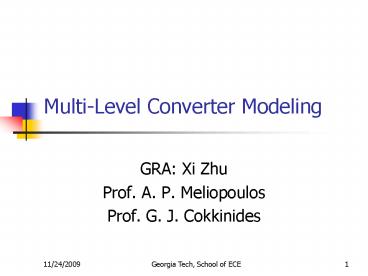MultiLevel Converter Modeling - PowerPoint PPT Presentation
1 / 23
Title:
MultiLevel Converter Modeling
Description:
... Level Converter using Diode-Clamp Topology. Motivation of Research (cont. ... It contains 12 valve sub-circuits, 6 clamping diodes and 2 Smoothing capacitors; ... – PowerPoint PPT presentation
Number of Views:2802
Avg rating:3.0/5.0
Title: MultiLevel Converter Modeling
1
Multi-Level Converter Modeling
- GRA Xi Zhu
- Prof. A. P. Meliopoulos
- Prof. G. J. Cokkinides
2
Motivation of Research
- Multi-level converter is an emerging technology.
- Benefits of Multilevel Converter Design
- Less harmonics contents
- Possible Transformerless connection
- Lower switching ra te
- Reduced switching loss
- Lower dv/dt, Less EMI
3
Motivation of Research (cont.)
- Develop a physically-based multi-level converter
models for VTB to study its behavior and control
in an integrated power system - There Exist Several Topologies. Our Work is on
Tri-Level Converter using Diode-Clamp Topology
4
Tri-Level Converter ofDiode-Clamp Type
- It contains 12 valve sub-circuits, 6 clamping
diodes and 2 Smoothing capacitors - Assume each smoothing capacitor has voltage E,
then phase voltage has three levels 0, E and 2E - Valves must follow certain rules to avoid short
circuit or invalid state - ( See Demo )
5
Proposed Approach Application Tri-Level Converter
Hardware Manager
Application Manager
6
Power Section Model
- Determine individual device circuit model
(Devices include Valves, Clamping Diodes and
Smoothing Capacitors) - Write state equations and create connectivity
pointer for each device - Apply connectivity constrain and use device
pointers to form overall state equations - Compute Algebraic Companion Form for the
converter for each time step.
7
Tri-Level ConverterPower Section
- Power Section Model contains
- 12 valve sub-circuits
- 6 clamping diodes
- 2 Smoothing capacitors
8
Valve State Equations
9
Valve Connectivity Table
Blue number state index within valve Red number
state index of converter
10
Clamping Diode Model
11
Smoothing Capacitor Model
12
Converter State-Space Model
Application of connectivity constraints to the
valve, diode and capacitor models yields the
overall converter state space model.
13
Converter Algebraic Companion Form
Application of trapezoidal integration yields the
Algebraic Companion Form
14
Multi-Rate Simulation
- Switching can occur between two fixed time steps.
Using fixed time step will generate erroneous
results - Our solution
- Detect upcoming switching in next time step
- Apply sub-step integration for t-h,t period.
15
Monitoring Estimation Section
- Purpose
- To derive control reference(s) from system
sampled data that may be corrupted by transients,
harmonics and may come from three phase
unbalanced system - Two advanced approaches are used
- Run-time Discrete Fourier Analysis
- Two-pass State Estimation
16
Run-time Discrete Fourier Analysis (DFA)
- Equations for Vab(t) as an example
- Compute base frequency using DFA.
- Extract the positive sequence component as
control reference - Pros and Cons simple computation but needs
minimum one cycle sampled data
17
Two-Pass State Estimation
- Two-pass state estimation approach
- Pass One
- Estimate phase voltage/current magnitude,
frequency and phase angle using state estimation
techniques for all phases - Pass Two
- Compute the average frequency from Pass one
- Fix frequency and estimate only magnitude and
phase angle for all phases - Extract the positive sequence component as
control reference - Pros and Cons No need for whole cycle data
samples but computation is intensive
18
Controller/Hardware Manager
- Controller model determines the switching
sequence of all the valves in the converter for a
specific objective - Controller model is application and objective
dependent - Example presented here
- Tri-level Inverter using PWM control with 3
controllable switching angles - Objective Elimination of 5th and 7th harmonics
with a specified Modulation Index
19
Tri-Level Converter Controller Example PWM with
Elimination of 5th and 7th Harmonics
(1). Phase A to Neutral Voltage Waveform is shown
in the right (2).Switching angles are to be
computed to eliminate 5th and 7th harmonics for a
specific Modulation Index.
20
Solution of Switching Angles
(1). Fourier Series Coefficients of 1st, 5th and
7th are shown here, where E is the actual
smoothing capacitor DC voltage
(2). By specifying a proper a1 value or
Modulation Index m value, and setting a5 a7
0, switching angles can be solved. Modulation
Index is defined as
(3). Above transcendental equations are solved
using Sylvester Resultant Criterion. When m
0.7, solutions are
21
Results of Switching Angles vs. Modulation Index m
22
Output voltages and Valve Switching Sequence (m
0.7 and 5th and 7th Harmonics are eliminated)
23
Summary
- Multilevel converter is an emerging technology.
It offers a lot of benefits. Computer model
enables the study of its behavior and control in
an integrated power system by simulation - A versatile methodology for computer modeling of
multilevel converter is presented which is
divided into three sections (1). Power Section
(2). Control Section (3). Monitoring and
Estimation Section. Multi-rate simulation
algorithm is implemented. - Tri-Level converter is used to exemplify the
methodology. A controller employing PWM with
selected harmonics elimination is used in the
example. Sylvester Resultant Criterion is used to
solve the transcendental equations for firing
angles.































